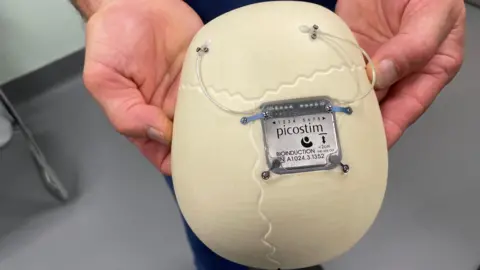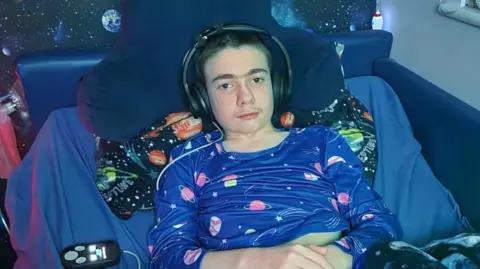A boy with severe epilepsy has become the first patient in the world to test a new device implanted in his skull to control seizures.
The neurostimulator, which sends electrical signals deep into his brain, has reduced Oran Knowlson’s daytime seizures by 80%.
His mother, Justine, told the BBC he was happier and had a “much better quality of life.”
The surgery was conducted in October at Great Ormond Street Hospital in London as part of a trial. At the time, Oran, now 13, was 12 years old.
Oran, from Somerset, has Lennox-Gastaut syndrome, a treatment-resistant form of epilepsy that he developed at the age of three.
Since then, he has experienced multiple daily seizures, ranging from two dozen to hundreds.
Last autumn, before the surgery, Oran’s mother explained how his epilepsy dominated his life: “It has robbed him of all of his childhood.”
She described Oran’s various seizures, including those where he fell, shook violently, and lost consciousness.
At times, he would stop breathing and require emergency medication to resuscitate him.
Oran has autism and ADHD, but Justine says his epilepsy is by far the biggest hurdle: “I had a fairly bright three-year-old, and within a few months of his seizures commencing he deteriorated rapidly, and lost a lot of skills.”
Oran is participating in the CADET project, which involves a series of trials evaluating the safety and effectiveness of deep brain stimulation for severe epilepsy.
This project is a collaboration between Great Ormond Street Hospital, University College London, King’s College Hospital, and the University of Oxford.
The Picostim neurostimulator used in the trials is manufactured by the UK company Amber Therapeutics.
How it works
Epileptic seizures are caused by abnormal bursts of electrical activity in the brain.
The device emits a constant pulse of current designed to block or disrupt these abnormal signals.
Before the operation, Justine expressed her hope: “I want him to find some of himself again through the haze of seizures. I’d like to get my boy back.”
The surgery, which lasted around eight hours, took place in October 2023.
Led by consultant paediatric neurosurgeon Martin Tisdall, the team inserted two electrodes deep into Oran’s brain, targeting the thalamus, a crucial relay station for neuronal information.
The margin of error for placing the leads was less than a millimetre.
The ends of the leads were connected to the neurostimulator, a 3.5 cm square and 0.6 cm thick device placed in a gap in Oran’s skull where bone had been removed.
The neurostimulator was then secured to the surrounding skull with screws to anchor it in place.

Deep brain stimulation has been tried before for childhood epilepsy, but until now neurostimulators were placed in the chest, with wires running up to the brain.
Martin Tisdall told the BBC: “This study is hopefully going to allow us to identify whether deep brain stimulation is an effective treatment for this severe type of epilepsy and is also looking at a new type of device, which is particularly useful in children because the implant is in the skull and not in the chest.
“We hope this will reduce the potential complications.”
That includes reducing the risk of infections after the surgery, and the device failing.

Oran was given a month to recover from the operation before the neurostimulator was activated.
When it is on, Oran cannot feel it. He can recharge the device daily using wireless headphones, allowing him to enjoy activities like watching TV.
We visited Oran and his family seven months after the operation to see how they were doing. Justine reported a significant improvement in Oran’s epilepsy: “He is more alert and has no drop seizures during the day.”
His night-time seizures are also “shorter and less severe.”
“I’m definitely getting him back slowly,” she said.
Martin Tisdall said: “We are delighted that Oran and his family have seen such a huge benefit from the treatment and that it has dramatically improved his seizures and quality of life.”
Oran is now taking riding lessons, which he clearly enjoys.
Although a nurse is present with oxygen, and one of his teachers is always nearby just in case, neither has been needed so far.
As part of the trial, three more children with Lennox-Gastaut syndrome will receive the deep brain neurostimulator.
Currently, Oran receives a constant electrical stimulus from his device.
‘The future looks brighter’
In the future, the team plans to make the neurostimulator respond in real time to changes in Oran’s brain activity, attempting to block seizures as they are about to occur.
Justine expressed her excitement about this next phase of the trial: “The Great Ormond Street team gave us hope back… now the future looks brighter.”
Oran’s family understands that his treatment is not a cure, but they are optimistic he will continue to emerge from the shadow cast by his epilepsy.
The Picostim neurostimulator, developed by Amber Therapeutics, has also been used to treat patients with Parkinson’s disease.


